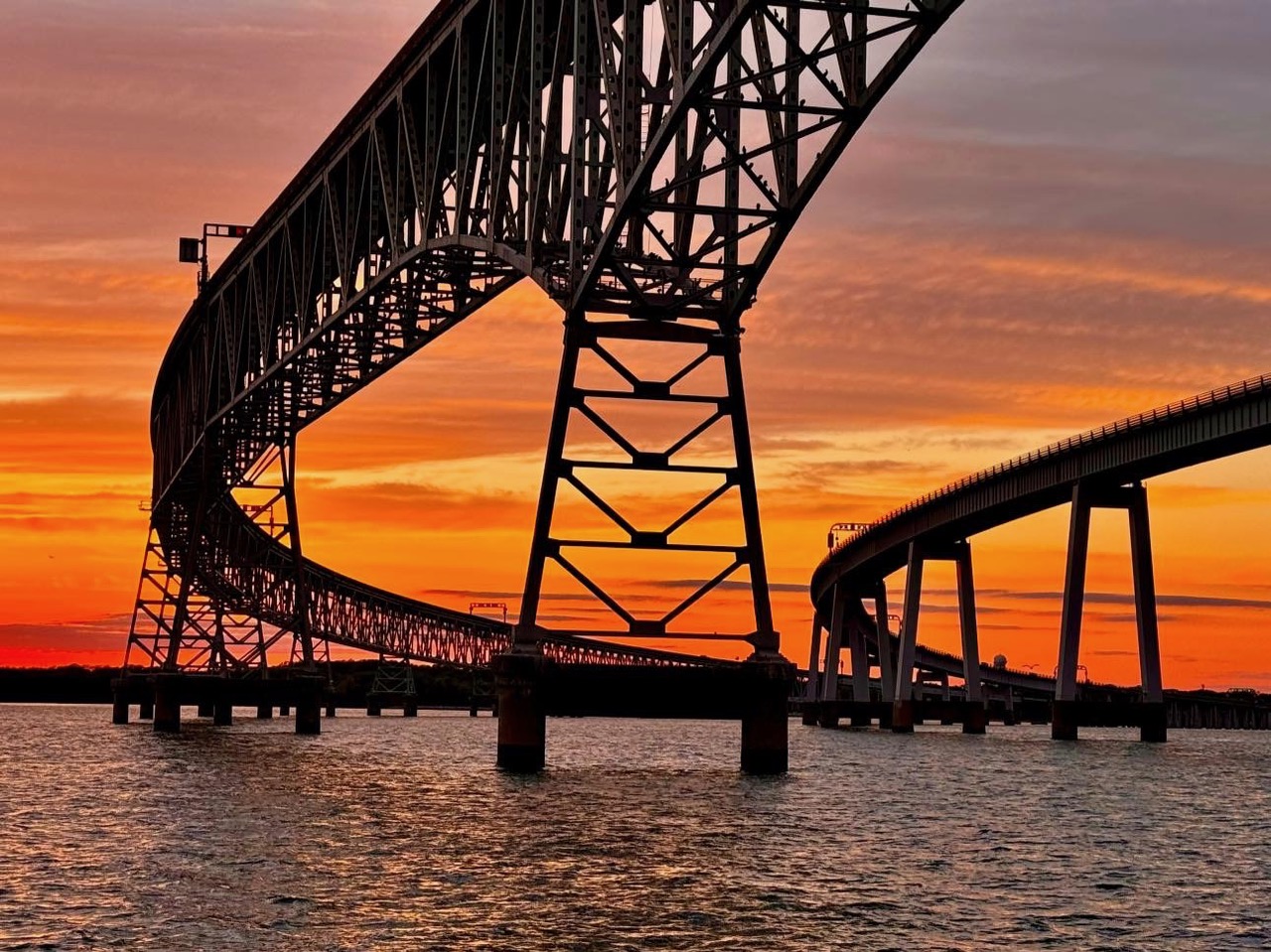
Chesepeake Lens: The Big Curve by David Sites
The Spy Newspapers may periodically employ the assistance of artificial intelligence (AI) to enhance the clarity and accuracy of our content.

Nonpartisan and Education-based News for Chestertown
The Spy Newspapers may periodically employ the assistance of artificial intelligence (AI) to enhance the clarity and accuracy of our content.
Birds’ Head Haggadah (c. 1300)
This year the Jewish celebration of Passover begins at sundown on April 22, and it ends after nightfall on April 30. Two Seder dinners will be held during Passover, and the Haggadah will be read to tell the story of the delivery of the Israelites from slavery in Egypt. The oldest extant illuminated Ashkenazi Haggadah is the Birds’ Head Haggadah (c.1300), copied and illustrated by the scribe Menahem. Not a scroll but a book, the Birds’ Head Haggadah measures 11’’x7.2’’ and contains 47 pages on parchment. Dark brown ink was used to write the text and outline the illustrations. Tempera was applied for color.

Making Matzo
The celebration of Passover is found in Exodus 12:1-28. Several scenes illustrate preparation for the Seder meal. “In the first month you are to eat bread made without yeast, from the evening of the fourteenth day until the evening of the twenty-first day.” (Exodus 12:18) The two-page illumination of making matzo starts on the right side of the page where a woman, wearing a red snood, has processed the grain. Since the original Passover occurred during the barley harvest season, matzo may have been made by mixing water with ground barley. Matzo is a flat unleavened bread. The figure in yellow is poking holes in the bread so it will not rise. The second woman with the red snood and the man in the green robe are saying a prayer over the matzo. On the next page, the man in the blue robe holds a tray of three matzo loaves, while the last figure in a red robe is baking the matzo. Since the Israelites needed to leave Egypt quickly, they had no time to allow the bread to rise.
The attire of the figures is interesting. They wear clothing appropriate to the time, but the male figures wear peaked hats. The fourth Lateran Council in 215 CE declared that male Jews must wear peaked Jewish hats. The heads of the Jews are represented by bird heads, thus the name of this Haggadah. The reason for this substitution is most likely a result of Jewish aniconism that forbids idolatry, the depiction of graven images. The bird heads have noticeably sharp beaks, which has led to speculation about the type of bird.

Passover Seder
At the far right of the Passover Seder, a man brings in the Paschel (Passover) lamb. “Tell the whole community of Israel that on the tenth day of this month each man is to take a lamb for his family, one for each household.” (Exodus 12:3) “The animals you choose must be year old males without defect.” (Exodus 12:5) The lamb can be identified as a male by it yellow horns. The lamb was not to be eaten with water, must have been roasted, and no bones broken. “Then they are to take some of the blood and put it on the sides and tops of the doorframes of the houses where they eat the meat.” (Exodus 12: 8) “On that same night I will pass through Egypt and strike down every first born—both man and animal.” (Exodus 12:12) The man with the lamb also holds a cup.
Five Jews are seated at the table, and each holds a cup representing one of the necessary components for the Seder plate. Unfortunately, the items are not illustrated. However, the first item on a Seder plate is the lamb shank. The second item is a roasted egg, a symbol of mourning, the first food served after a funeral. Bitter herbs or horseradish are the third item on the plate, and they represent the harshness of slavery in Egypt. Forth is haroset, a sweet brown mixture that is a symbol of the bricks and mortar used to build Egyptian structures. Fifth is a fresh green vegetable that is dipped in salt water, representing hope and renewal.

Exodus
The illumination of the Exodus covers two-pages. On the left page, Moses in the red robe and holding his staff, leads the Israelites. Behind him, four figures, with their heads raised toward heaven, carry their belongings as they leave Egypt. Two figures hold the matza. On the next page, the Pharoah, on horseback, is dressed as a European King. A knight carries a standard. The faces of the non-Jews, without bird beaks, lack features.
Two Jews, one on horseback, follow. Behind them is a carriage and some Egyptian soldiers. In the Birds’ Head Haggadah most of the men wear Jewish peaked hats, but not all do.

Crossing the Red Sea
Crossing the Red Sea might seem a difficult event to depict. Menachem has settled on a simple and effective solution. Moses lowers his staff and the water parts, allowing the Israelites to cross.

Manna and Quail
The Exodus story tells that the Israelites grumbled because they had no food, and God heard their cries. “I will rain down bread from heaven for you.” (Exodus 16:4) Two men lean down to gather the yellow, green, and red manna, the bread of Heaven. “That evening quail came and covered the camp” (Exodus 16:13). A red quail can be seen in the center of the illumination. The hands of God, extending from heaven, offer what appears to be matza.
On the first page of the Birds’ Head Haggadah, a man and woman sit at the Seder table. The woman passes him matzo to begin the ritual. The last page contains a depiction of the rebuilt Temple of Jerusalem.
Note: Matzo is the Ashkenazi pronunciation which deletes the letter “h” from the end of the word. Matzah can be found in both Ashkenazic and Sephardic texts.
Quotes from the Book of Exodus are taken from the New International Version of the Holy Bible.
The Spy Newspapers may periodically employ the assistance of artificial intelligence (AI) to enhance the clarity and accuracy of our content.
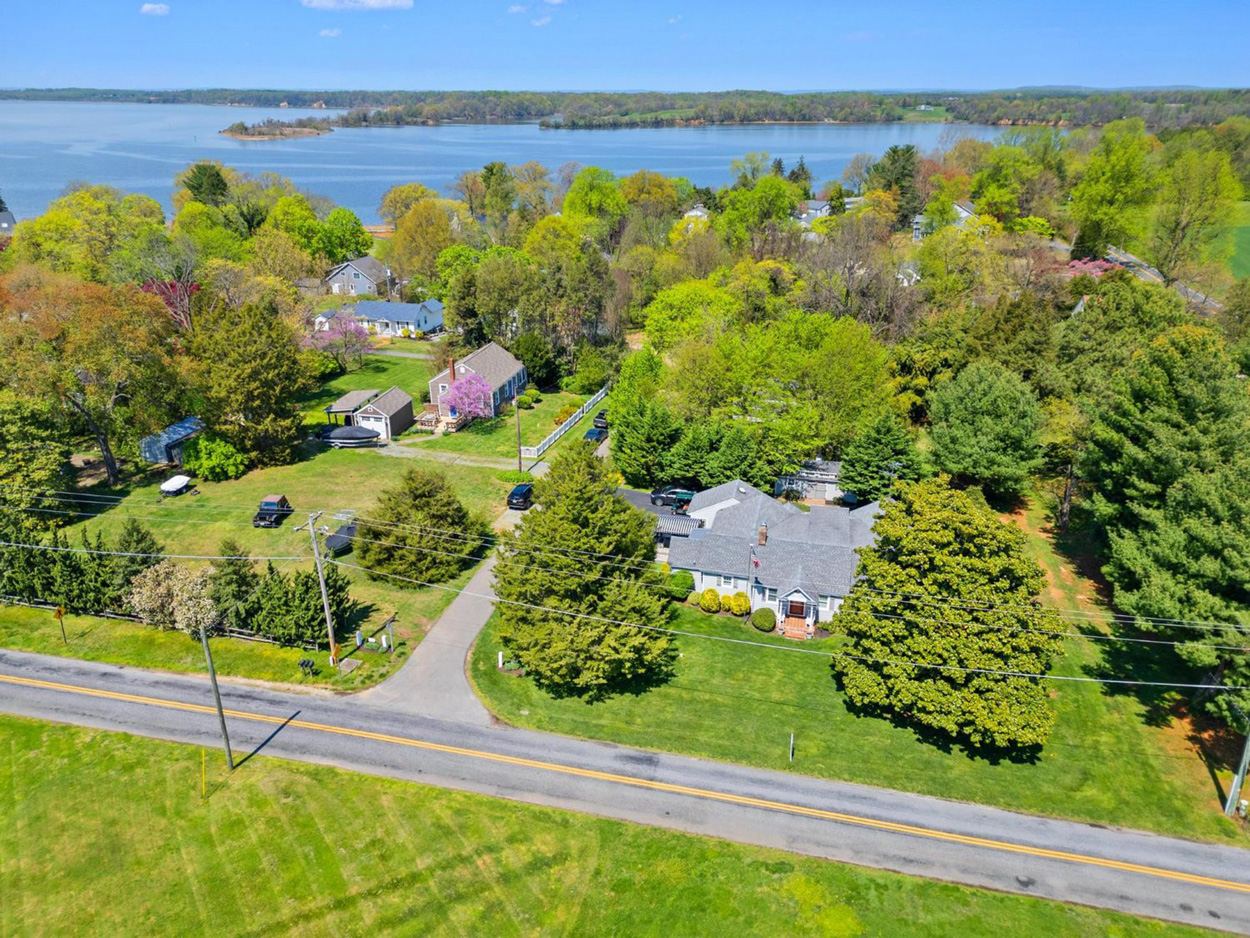
Aerial view from front to water
I have featured Kent County’s Kentmore Park neighborhood once before so I welcomed another opportunity to visit this small private community with waterfront lots along the Sassafras River leading to the Chesapeake Bay. Before my tour, I parked my car at the community’s private beach by the pier and boat ramp. With my back to the water, I enjoyed the picturesque vista of houses dotting the steep hills rising from the beach. Then I drove back to start my tour of today’s feature that is nestled in a clearing surrounded by mature trees for privacy.
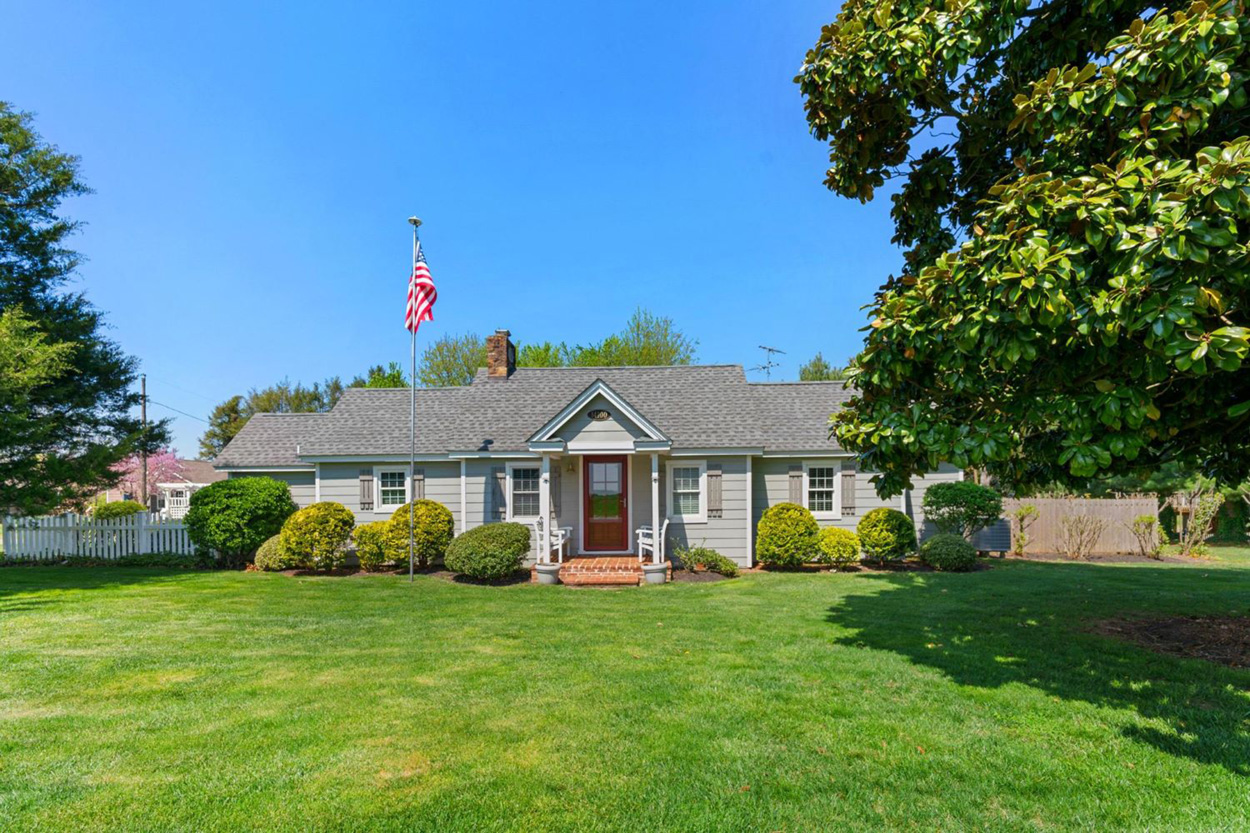
Front elevation
This charming cottage was originally built in 1929 by Jacob Smith and for many years it remained known as “The Smith House”. Before I went inside, I admired the cottage’s curb appeal from the footprint’s setbacks that break up the massing to create architectural interest, the cottage-style shutters, and the cozy front porch with benches. In Feng Shui, a red door says “welcome” since it is the point where the flow of energy enters the house and this half glass, half wood red door also accents the exterior color palette of light gray siding, darker shutters, and white trim.

Main house rear elevation
The rear elevation is an artful arrangement of multiple gables topped with a shed dormer. The lowest gable covers an outdoor shower for clean-up after a day on the water or relaxing on the beach.
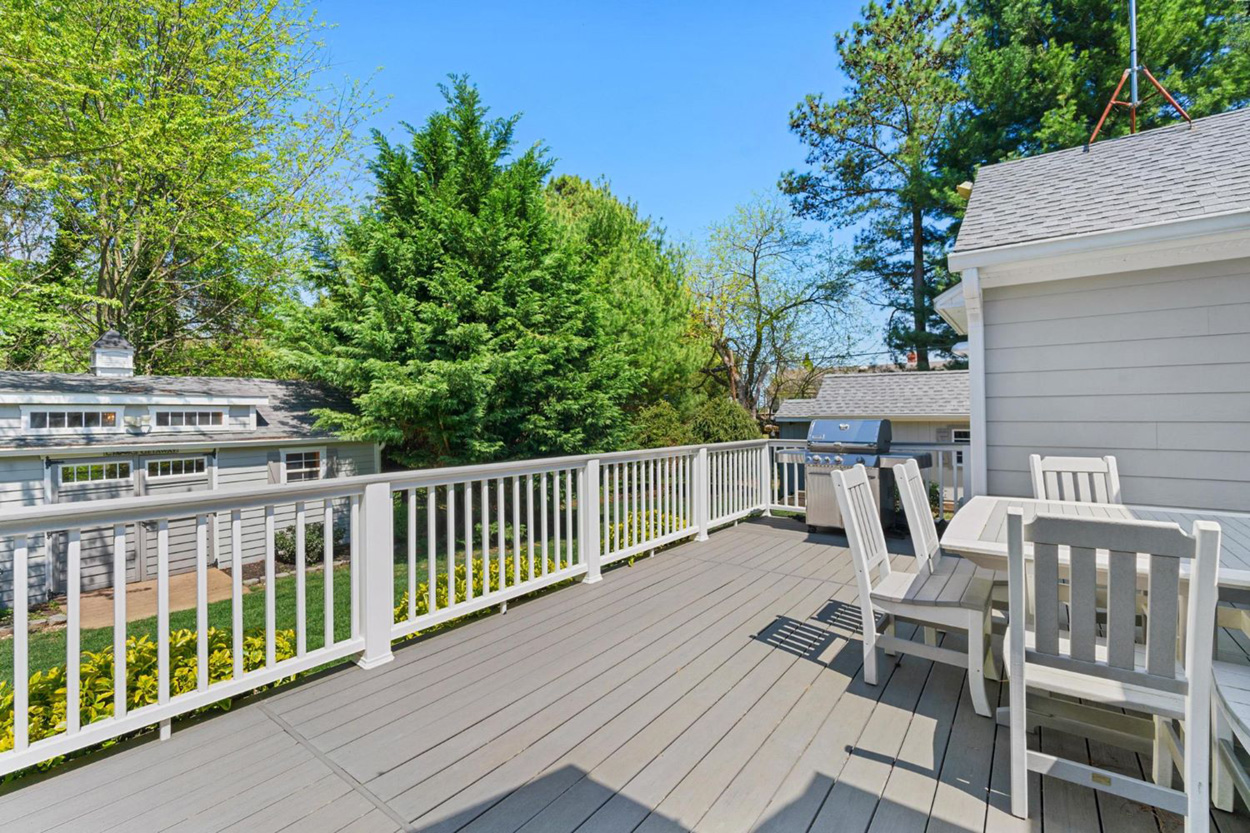
Rear deck to the lawn
The spacious deck is a wonderful outdoor room that has a retractable awning for seasonal shade. The grille, table and chairs set the scene for dining al-fresco. The sloped lawn leads to the “man cave/she shed”.

Terrace with awning to garden
At the side of the house, another outdoor room has a fabric canopy for shade over the hardscaped terrace overlooking the landscape. The white picket fence, shrubbery, and plants provide privacy from the side street. The hardscape walkway leads to the cottage’s side door where I began my tour.

Open kitchen, dining room, and living room, view from side door at terrace
The side door opens into a one-story foyer with a door at the side wall to the full bath that is also a convenient powder room. Walking through the foyer, my vista expanded into the open plan kitchen-dining-living room that ends at the library nook with a display of lighted miniature buildings on the top shelf. I admired how the kitchen’s white cabinets blend into the walls and the white ceiling that reflects the light over the beautiful wood floors. The island’s warm light blue island cabinetry, granite countertop and stainless steel appliances are great accents.

Vista from living room, dining room, kitchen, door to terrace
Past the kitchen-dining area’s flat ceiling, the roof’s long flat dormer cuts through the spatial geometry. I could easily linger on the living area’s loveseat to enjoy the sunlight from the window wall of triple windows, transoms and the shed dormer transoms. Like the kitchen cabinetry, the neutral color sofas blend into the background and make the room feel more spacious, accented by the accents of color in the wood furnishings and the floral rug. Between the living room and dining area is a doorway to another small foyer with cabinetry for wine storage that is convenient to the adjacent deck.

Vista from living room to den
Across from the living room area is a large model sailboat resting on a high ledge illuminated by downlights above the pair of sliding French doors that lead to the adjacent den. The cabinetry behind the grandfather clock becomes a hutch for the dining area with glass fronts on some of the upper cabinets for glassware display. The countertop does dual duty as a coffee bar and buffet.

Spacious den/office space
The ceiling height changes again in the spacious den/office space. Stained beams articulate the white plaster ceiling and become a grid against the white slats. Vertical wood paneling covers the wall around the fireplace with built-in millwork on one side. On the other side of the fireplace is an antique glass fronted case with crystal trophies from the Owner’s sailing career. Whether you are working at the desk or relaxing on the comfortable chairs by the fire and/or TV, this is a very pleasant multi-purpose space.

Primary Bedroom
The spacious primary bedroom suite is located at the quietest corner with abundant sunlight from the arrangement of windows. Opposite the bed is a wall of closets. The wood furnishings and neutral color palette create a restful retreat with views of the landscape.

Guest Bedroom 1
Two guest ensuites are located at the front corners of the house. This bedroom with the carpet’s subtle texture, light walls, white furniture and patterned bed linens would please any guest.

Guest bedroom with barrel vault
The other guest ensuite’s bath is also the powder room for the house. I admired the ceiling’s barrel vault, detailed in wood strips and slats like the bottom of a boat. The pale pink walls, paisley bed linens and mix of white and rattan furnishings creates another restful retreat for a guest.

Bunk beds in hall between garage and house
Just like boat design that must make every inch of space count, I admired how the hall from the garage to the house also provides extra sleeping space for guests and a closet for coats. The bedding’s colorful quilts and pillows stand out against the white walls and the white rails keeps young children safe.
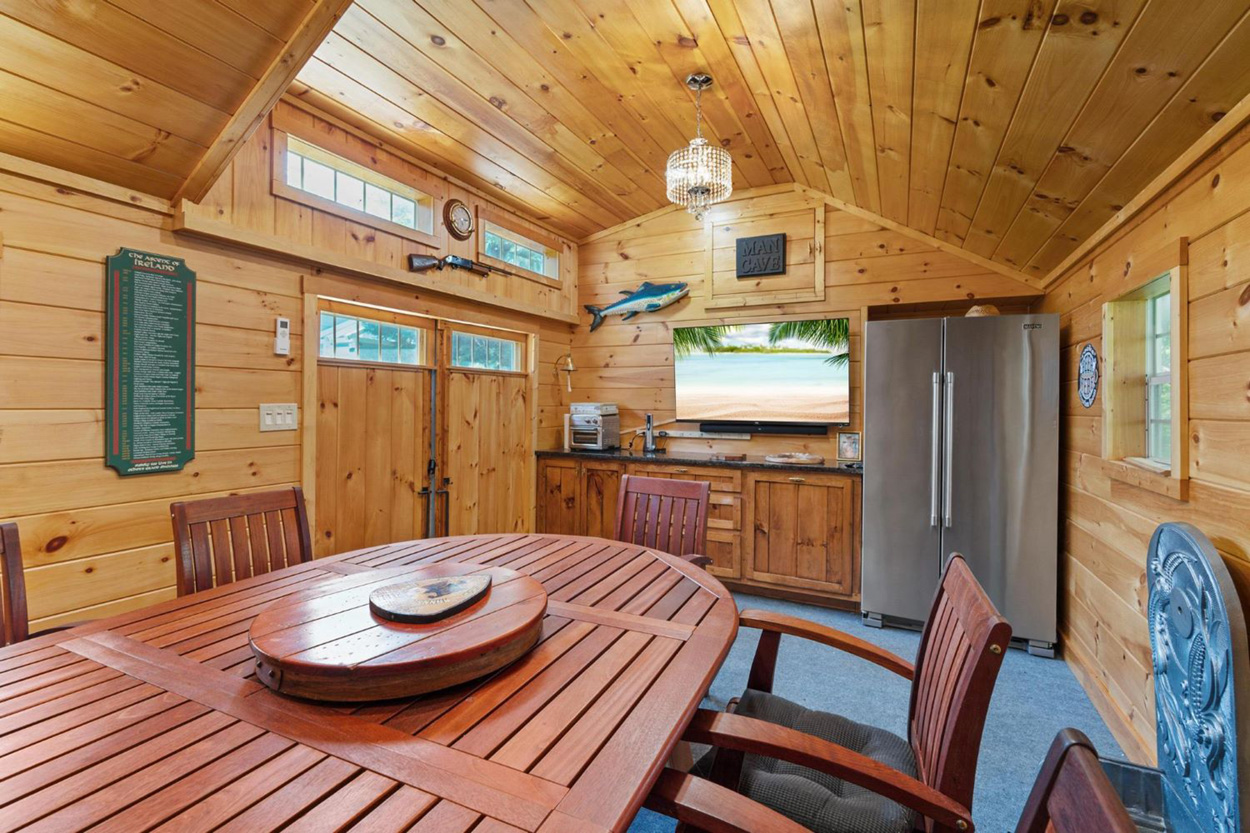
Man cave interior
Should one wish to retreat from guests, the detached “man cave/she shed” is the perfect place. The wood entry doors with transom, wood walls, ceiling and cabinetry create a cabin feel, complete with a refrigerator for snacks and drinks. Should one wish company, the teak table seats six.
The property also includes a shed with storage for lawn and garden maintenance and space for storing the golf cart for driving down to the community waterside park.
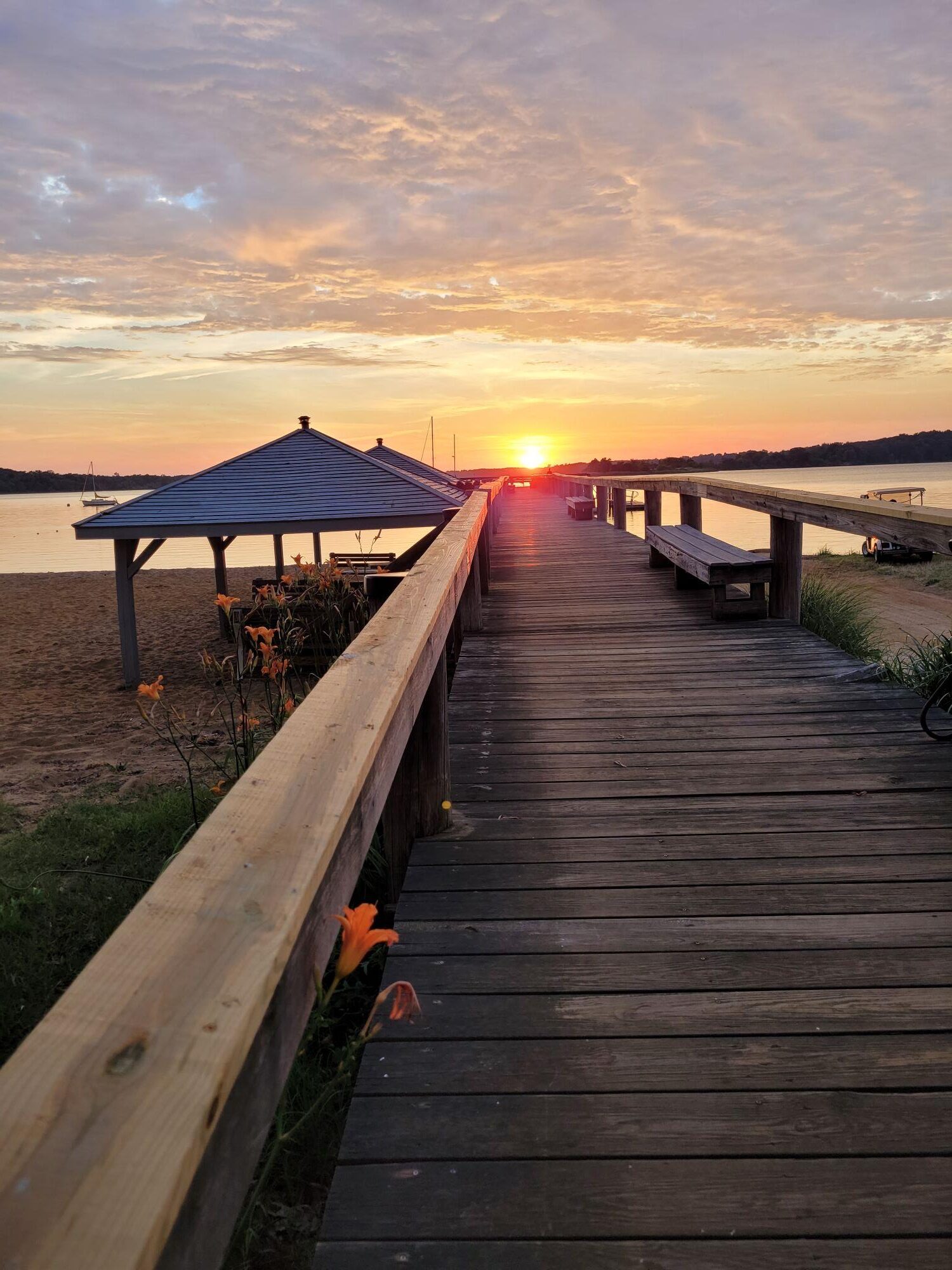
Pier at sunset
I love the Italian custom of a “passeggiata” – walking in the neighborhood after dinner to greet one’s neighbors and to keep up with news. After walking down this community’s hill, you are rewarded with a sunset view over the Sassafras River. During the day, various benches beckon one to linger for a dose of Vitamin D to watch the sailboats gliding over the water. Kentmore Park is a special community that has been very keen on sailing for many years and the Sailing Club is open to any resident. The seasonal Saturday races are a neighborhood event with trophies awarded after each season’s end at the Sailing Club banquet. Landlubbers can also take advantage of the Club’s sailing lessons or could spend the afternoon paddling a kayak. The pavilions offer shade for picnics with family or friends.
Water-oriented community, desirable corner lot with a charming one level cottage for aging in place, great open-plan living-dining-kitchen area, a partial basement for storage and mechanical equipment, outdoor rooms of the rear deck and side terrace, detached “man cave/she shed” for additional living space and another outbuilding for storage-perfect cottage living!
For more information about this property, contact Patricia Kern with Gunther McClary Real Estate at 410-275-2118 (o), 443-480-4018 (c) or [email protected], www.gunthermcclary.com, “Equal Housing Opportunity”.
Photography by Steve Buchanan Photography, 410-212-8753, [email protected]
The Spy Newspapers may periodically employ the assistance of artificial intelligence (AI) to enhance the clarity and accuracy of our content.
Author’s Note: I had a lot of fun writing this poem, playing with the idea of time as not just an abstract backdrop to our changing lives, but an actual teacher in whose classroom we learn and grow, and from whose care we eventually depart. As I wrote, she really came to life for me: a little flakey, a lot of fun, weirdly sentimental (she truly misses those trilobites!) and possessing a highly eccentric sense of humor (boy does she find Shakespeare’s sonnets hilarious, but why? only she knows).
Time The Teacher
was often late for class, would arrive
with her keys, her plums, her unwritten
poems, makeup spilling from
her hobo bag of exasperations;
rarely took attendance except
with sometimes sudden and alarming
urgency (a panicked mother
shouting runaway names
in the grocery parking lot);
always seemed to call on you
when you weren’t paying attention;
snorted at every request for extra credit.
Wore her graying hair up in a girlish
ponytail, and her bifocals on a chain
around her neck. Graded our papers
in disappearing ink; often digressed;
thought little of the Bible, or Americans,
(except for Dickinson); seemed to enjoy
scandalizing us with casual details from
old exploits: Byron, Picasso, Kahlo,
and others too numerous to mention, though
mention them she did (gasps when
she winked yes for Bieber); dropped
the c-word like she was dropping
all pretense. Said wisdom wasn’t
worth much more than sheer pluck;
kept a pickle jar of sand on her desk
and asked us to guess how many
grains it held; always knew
when it was your birthday and
brought cupcakes. Sobbed dis-
concertingly during presentations
on dinosaurs and trilobites, and the
Cambrian explosion. But laughed
through our recitals of Shakespeare’s
sonnets: “oh my god, stop it, you’re
killing me!” she’d groan at That Time
of Year Thou Mayst in Me Behold,
pounding her fist on the desk, holding
her sides, the clock on the wall not
budging an inch till she was done.
♦
Julian Koslow is a former professor of Renaissance literature at Virginia Tech but left academia to take care of a child with special needs. His poems have appeared or are forthcoming in Sugar House Review, The Columbia Review, SRPR, Cumberland River Review, New Ohio Review, and Atlanta Review. He lives with his wife and two sons in Fair Lawn, New Jersey.
The Delmarva Review, a literary journal, reaches audiences regionally, nationally, and beyond, to give writers a desirable home in print (with an electronic edition) to present their most compelling new prose and poetry. This is a time when many commercial publications have closed their doors or are reducing literary content. For each annual edition, editors have culled through thousands of submissions to select the best of new poetry, fiction, and nonfiction. There is never a publishing or reading fee to the writers. The review is available from online booksellers and regional specialty bookstores. As a 501(c)(3) nonprofit, support comes from tax-deductible contributions and a grant from Talbot Arts with funds from the Maryland State Arts Council. Website: www.DelmarvaReview.org
# # #
The Spy Newspapers may periodically employ the assistance of artificial intelligence (AI) to enhance the clarity and accuracy of our content.
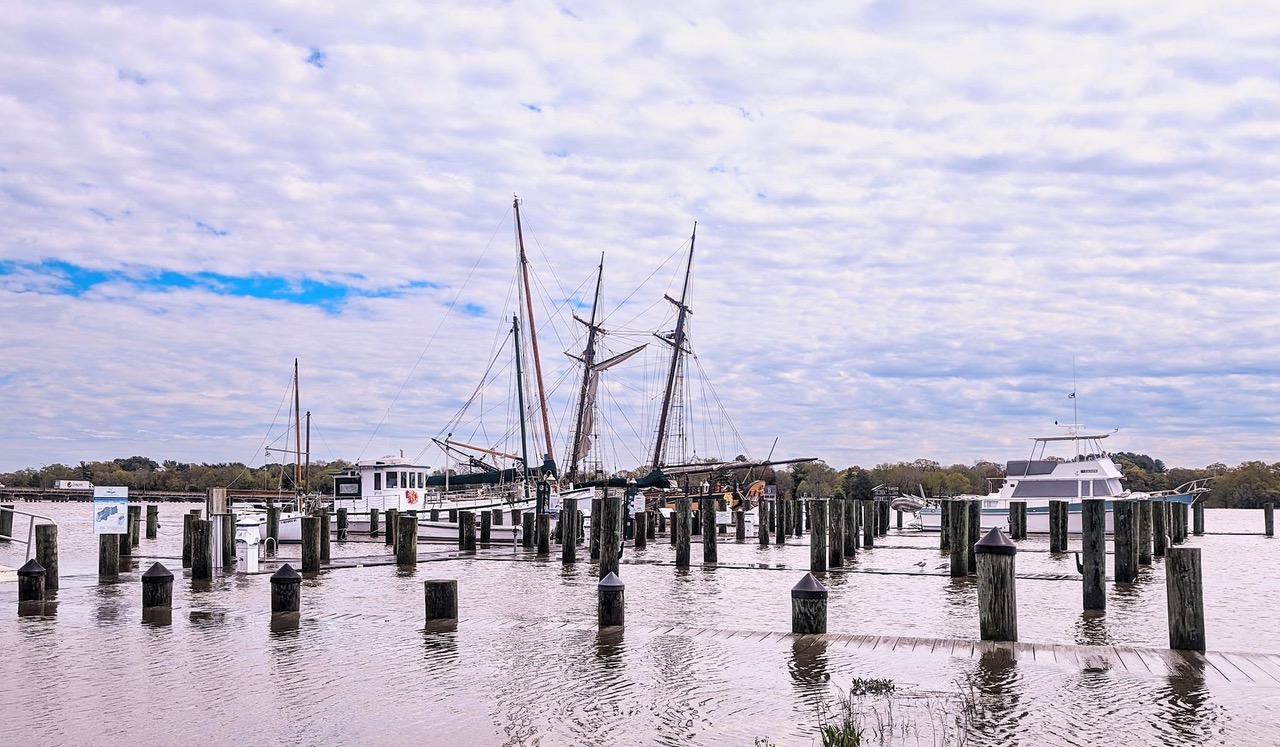
A super high tide and buckets of rain brought water over the Chestertown docks last weekend. “Aqua Alta” by Hanson Robbins.
The Spy Newspapers may periodically employ the assistance of artificial intelligence (AI) to enhance the clarity and accuracy of our content.
If you were born during the month of April, the daisy is your birth flower. Ancient Egyptians grew daisies for their medicinal value. Eating daisies was thought to relieve the pain of stomach ulcers and gout. King Henry VIII of England used them for that purpose. A Roman myth tells of Vertumnus, the god of seasons, gardens, and orchards, who saw Belides, the nymph protector of the forest, fell in love with her, and pursued her relentlessly. In desperation, she turned herself into a daisy. The daisy’s scientific name Bellis was derived from this story.
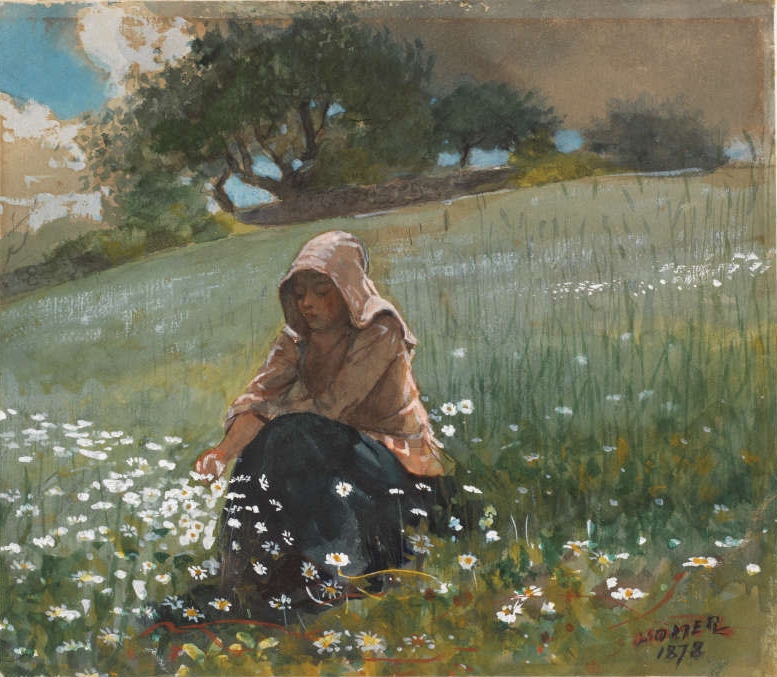
“Girl and Daisies” (1878) | Winslow Homer
The daisy is a symbol of innocence, purity, and true love. In “Girl and Daisies” (1878) (watercolor), by American artist Winslow Homer, a young woman sits among white daisies in a field on a sunny afternoon. Pensive, she reaches out to touch a daisy. No one is near, the day is calm, and her thoughts are her own. What is she thinking about? Homer invites the viewer to sit quietly with her among the flowers. The daisy is a composite flower, two flowers in one, in perfect harmony, representing true love. Perhaps that is what she ponders.
Homer painted “Girl and Daisies” shortly after the end of the Civil War. His focus at the time was on farms, fields, flowers, children, and other simple things. Americans were nostalgic for the pre-Civil War life. Homer had been on the front lines from 1861 until 1865, covering War for Harper’s New Monthly Magazine.
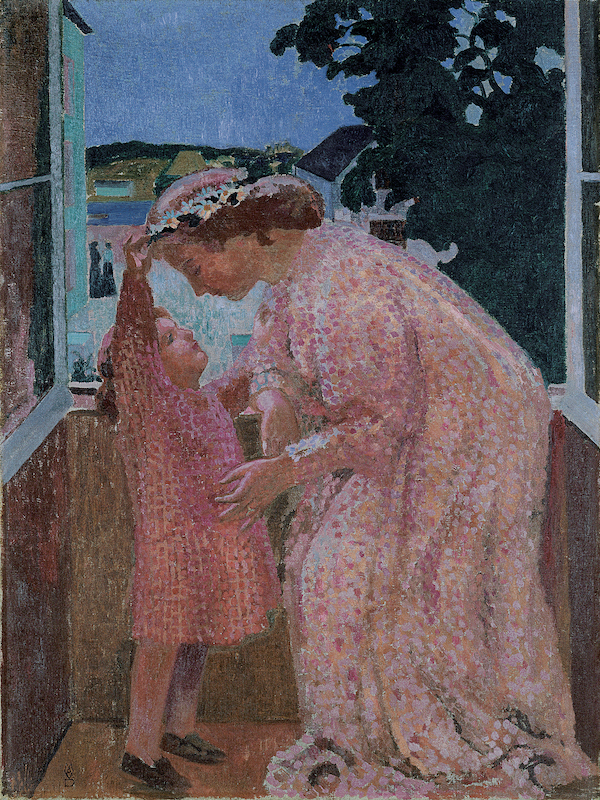
“The Crown of Daisies” (1905-06) | Maurice Denis (1870-1943)
“The Crown of Daisies” (1905-06) (29’’x22’’) was painted by French artist Maurice Denis (1870-1943), a member of the Nabi, a group of artists who wanted to make art in a style that combined both art and decoration. They were influenced by the Impressionists and Post-Impressionists. “The Crown of Daisies” is a depiction of a young married woman and her child, a simple subject drawn from everyday life, but painted in a highly decorative style. He uses Seurat’s pointillist technique to create the dresses of the two women, and parts of the background wall, window, and the houses visible through the window. The large leaves outside the window are painted in silhouette, and the very distant landscape and sky are rendered without dots. By mixing the decorative devices, Denis has created a charming painting.
In England, the daisy was called “day’s eye” because its petals close over the yellow center at night, and open as day beings. Young girls often wore crowns of daisies. Yellow daisies were symbols of joy, optimism, and friendship. Blue daisies represented loyalty, honesty, and trust. In Victorian flower symbolism the daisy could also mean “your secret is safe with me.” Daisies pop open in the sun: “Ups-a-daisy” was an expression said to children to encourage them to get up after they fell. “Oopsy daisy” and “whoops-a-daisy” were used when someone made a mistake, or tripped.

“Daisies” (1939) | Henri Matisse
Henri Matisse’s painting “Daisies” (1939) (36”x26”) presents a modern take on the daisy. The pose of the lady in red suggests innocence, although the color red traditionally conveys the opposite. The nude female’s position suggests physical love. The idea of innocence and true love, communicated by the white daisies, and the blue daisies message of loyalty and trust most likely were not on Matisse’s mind when he made the painting. The lemons on the table have two different interpretations; they represent longevity, purification, love, friendship, and have the power to foil negative energies and the evil eye. They also are symbolic of disappointment and bitterness. The green vase is a Greek amphora that was used to hold oil, wine, milk, or grain. Matisse’s “Daisies” is a sensuous painting.
“Daisies” was painted in 1939, months before the Nazi invasion of Paris. Paul Rosenberg, a prominent art dealer, was forced to flee France, leaving behind his large art collection. “Daisies” was among the paintings seized by the Nazis. Thanks to the United States Army, “Daisies” was recovered and returned to Rosenberg. He placed it in his new gallery in New York City.
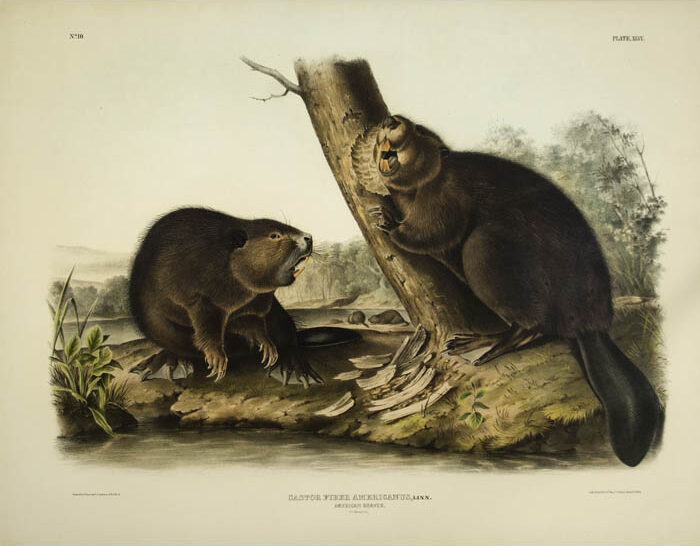
“American Beaver” (1844) | John James Audubon and his sons, published in Viviparous Quadrupeds of North America
If you were born between April 20 and May 20, your Native American totem animal is the beaver. “American Beaver” (1844) (21”x27”) was one of 150 lithographs by John James Audubon and his sons, published in Viviparous Quadrupeds of North America (1845-48). Beavers were observed to work hard, always in groups, to take care of the family, and to be determined to complete their work. For these reasons beavers were important animals in most Native American cultures for their persistence, perseverance, resourcefulness, and ability to adapt to situations. Several American Indian tribes had Beaver Clans, groups with matrilineal blood ties. Images of beavers were frequent on totem poles, masks, and on decorative objects worn on ceremonial occasions.
Audubon depicts two beavers communicating with each other by making sounds. They also communicated by slapping their tails. Audubon also has depicted the rich, thick fur coat that made the beaver a popular animal for trappers.
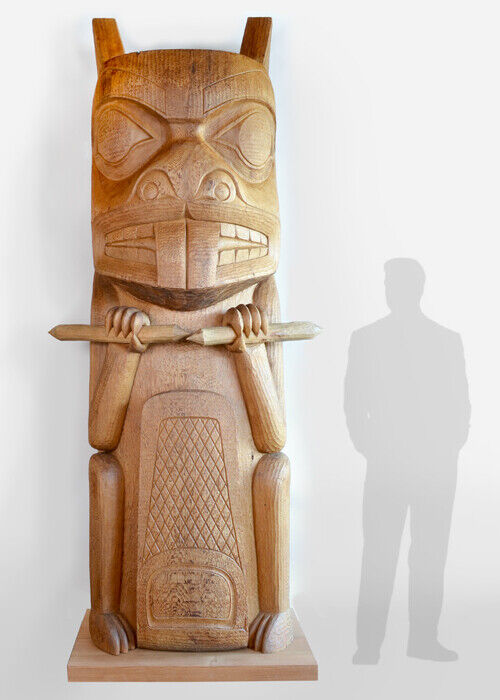
“Beaver Totem Pole” (1976) (9 feet) (red cedar) | Walter Harris (1931-2009).
“Beaver Totem Pole” (1976) (9 feet) (red cedar) was carved by Walter Harris (1931-2009). He was born in Kispiox, British Columbia. A wood carver, he attended the Gitanmaax School of Northwest Coast Indian Art in 1969, and he was a senior carving instructor at the school from 1972 until 1985. Harris’s image of the beaver follows the tradition of including large eyes, two very large front teeth, and both front legs raised with claws prominently displayed. In this work the claws hold pieces of wood. The beaver’s tail is decorated with a cross-hatch pattern.
Harris is the hereditary Chief of the Village of Kispiox, where he carved and raised a totem pole sometime during 1970’s. It was the first traditional totem pole raised in modern times. He considers totem poles are the heart of Native American Culture: “They are our deeds to the land. They serve as witnesses to the encounter of our ancestors with the supernatural beings who control all the fish, animals, and plants in our world. They are our charter of rights from time immemorial.”

“Amik Beaver” (2017) (acrylic) | Frank Polson (b.1952)
“Amik Beaver” (2017) (acrylic) was painted by Frank Polson (b.1952), a member of the Algonquin Long Point First Nations community. Polson remembers working with his father on his trap lines. He remembers drawing beaver and moose. He dropped out of art school several times, was incarcerated for five years in a federal prison, and finally found art again. He used house paint and old jeans and bedsheets for his canvas. Visitors started buying his art. Inspired by the lessons of the Native American elders, and his childhood memories, he has become a respected artist, and has created over 2,700 paintings.
Polson’s “Amik Beaver” falls into the category of “Woodland” style. Polson said, “I’ve adopted my artistic heritage in a way that my elders would have never imagined, expressing my aesthetic, political, and social views in a range of styles and media.” His use of color is dynamic, and his lines are forceful, similar to those found in ancient totem poles, masks, costumes, jewelry, and objects used in rituals. Polson has emphasized the beaver’s flat tail and its sharp claws. He chooses images of North-Western Quebec’s wildlife, and adds images from legends, rituals, and nature with the intent to “build a bridge between cultures.”
The word amik in the Algonquin language means beaver. The beaver was the mascot of the 1976 Summer Olympics in Montreal.
Beverly Hall Smith was a professor of art history for 40 years. Since retiring with her husband Kurt to Chestertown in 2014, she has taught art history classes at WC-ALL. She is also an artist whose work is sometimes in exhibitions at Chestertown RiverArts and she paints sets for the Garfield Center for the Arts.
The Spy Newspapers may periodically employ the assistance of artificial intelligence (AI) to enhance the clarity and accuracy of our content.
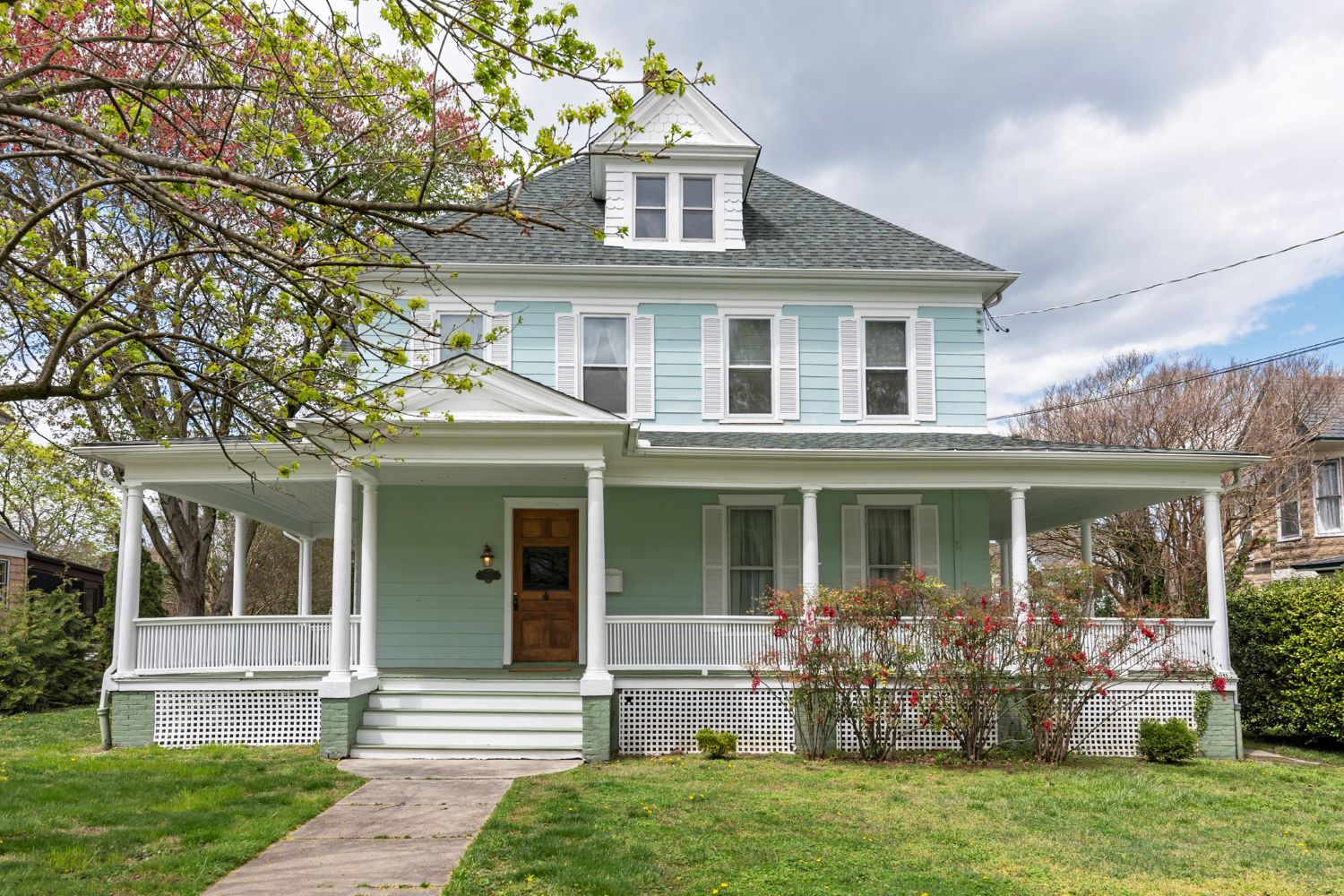
Full front elevation Four-Square Fabulous
Now that Dorchester County is part of my beat, I am enjoying becoming acquainted with Cambridge’s historic neighborhoods. This house caught my eye for several reasons; its location only two blocks from the Choptank River, its deep lot, and its modified American Four-Square architectural style. Features of this style include its boxy footprint with square rooms; two and a half stories; hipped roof with a center dormer at the third floor and a large front porch with a pediment over one bay of the porch above the stairs to the asymmetrically placed front door. I especially liked the detailing of the third-floor dormer with its pediment of scalloped lap siding and the two additional rows of scalloped siding on either side of the double-unit window as well as the lack of corner boards at the exterior corners of the house. The simple exterior color scheme of light lap siding, white trim cornice board, shutters, porch columns and railing and the lattice infill between the brick piers supporting the porch framing gives this distinctive house great curb appeal.
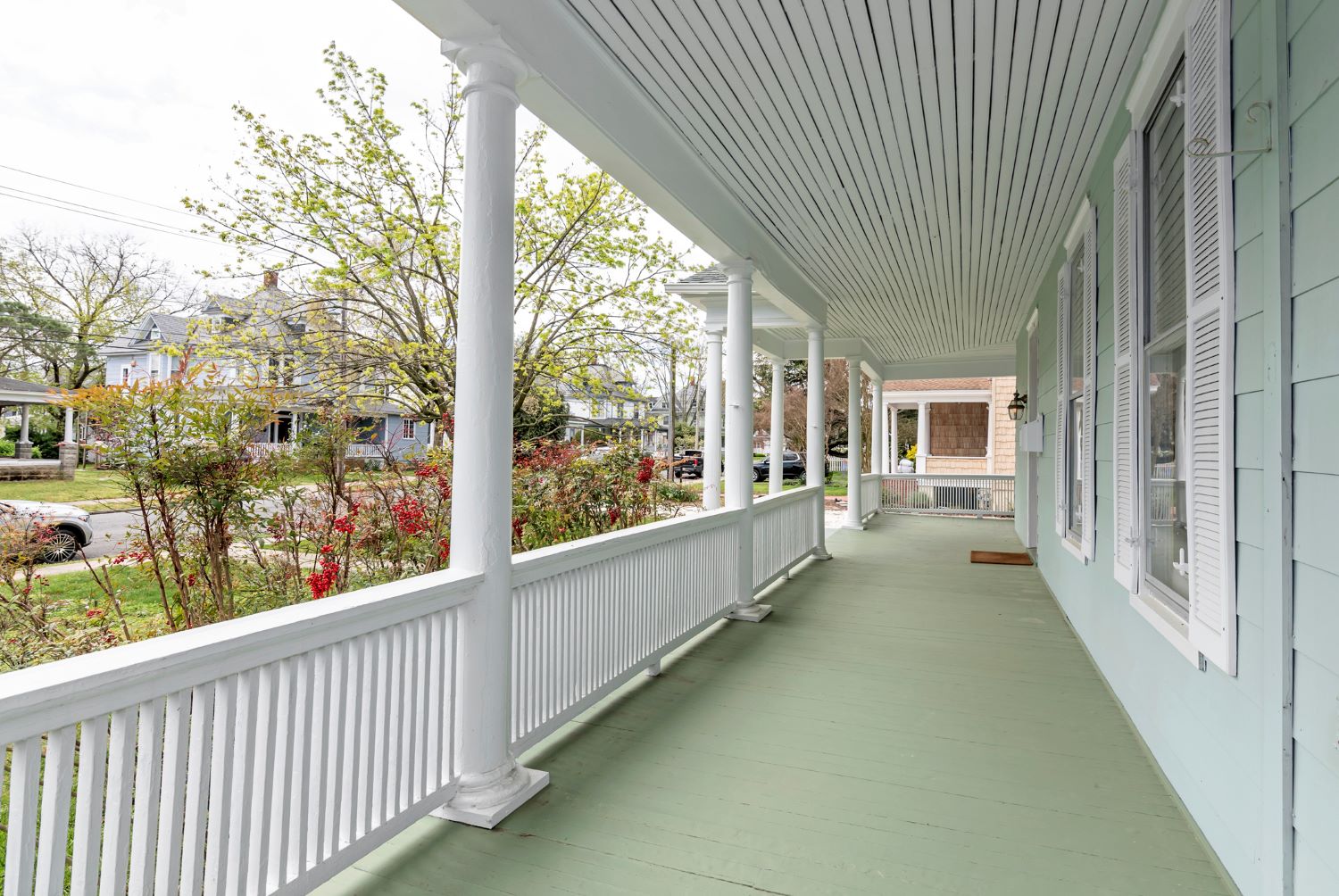
Close-up of the porch overlooking yard
This porch is a delightful outdoor room detailed with painted light green flooring and wood slat ceiling. The finishing touch would be white rattan chairs with cushions for relaxing at the end of the day with one’s pet and interacting with neighbors on their daily strolls.

Front-left side elevation shows the bay-shaped two-story wall projection
The porch wraps around both side elevations of the house. This side elevation also shows the bay-shaped two-story wall projection that breaks up the box to add character to the massing. The French door at the end of the porch leads to the dining room for easy outdoor-indoor flow.
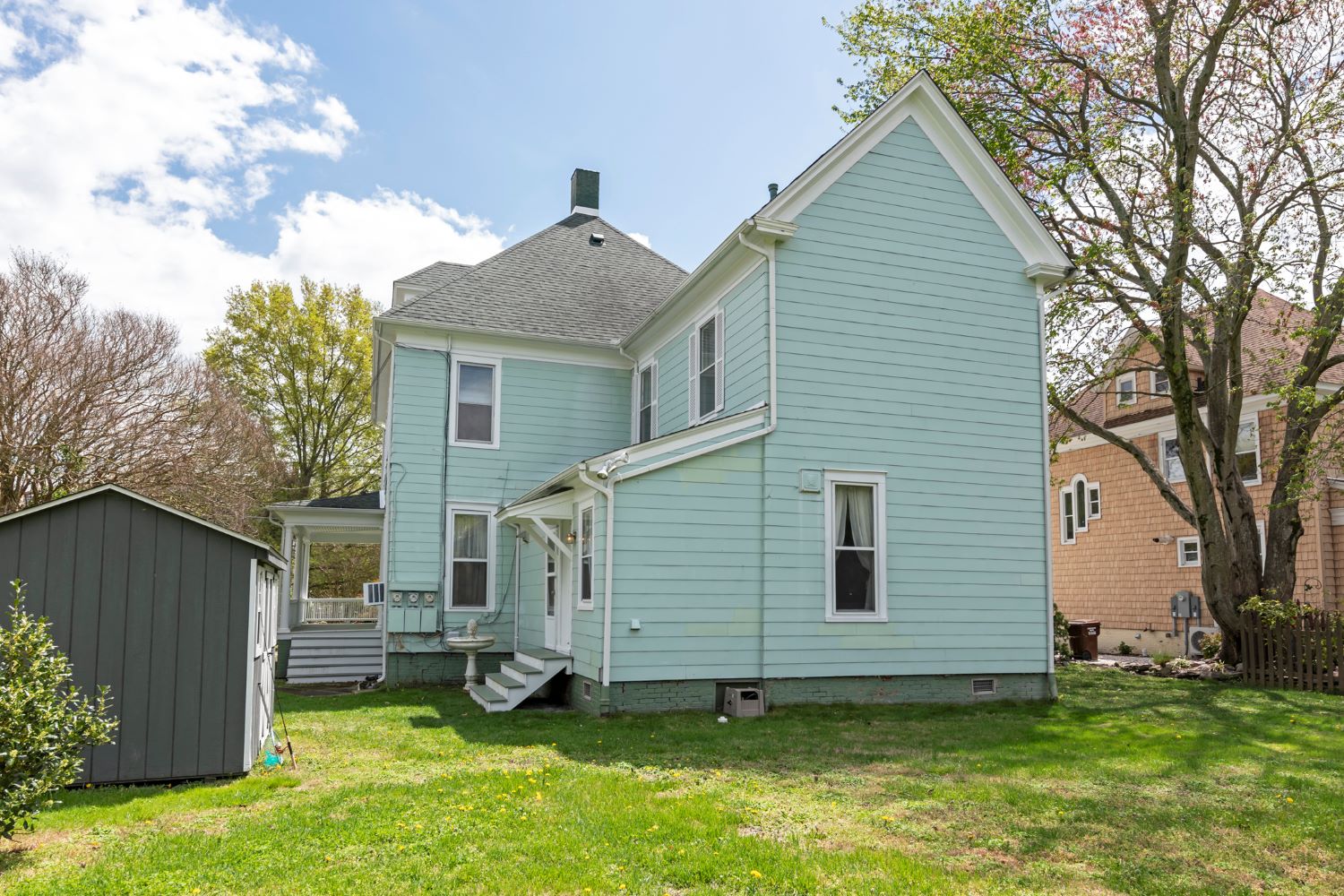
The rear elevation shows the addition with its pitched roof/shed roof form that telescopes down from the main hipped roof. I would be tempted to complete the indoor-outdoor flow by adding a deck to connect the wrap-around porch to the addition’s side wall. Since an exterior door leads to the kitchen, the deck would be a great spot for grilling and built-in seating could be incorporated into the railing design. One set of steps could be relocated for access to the driveway and the yard.
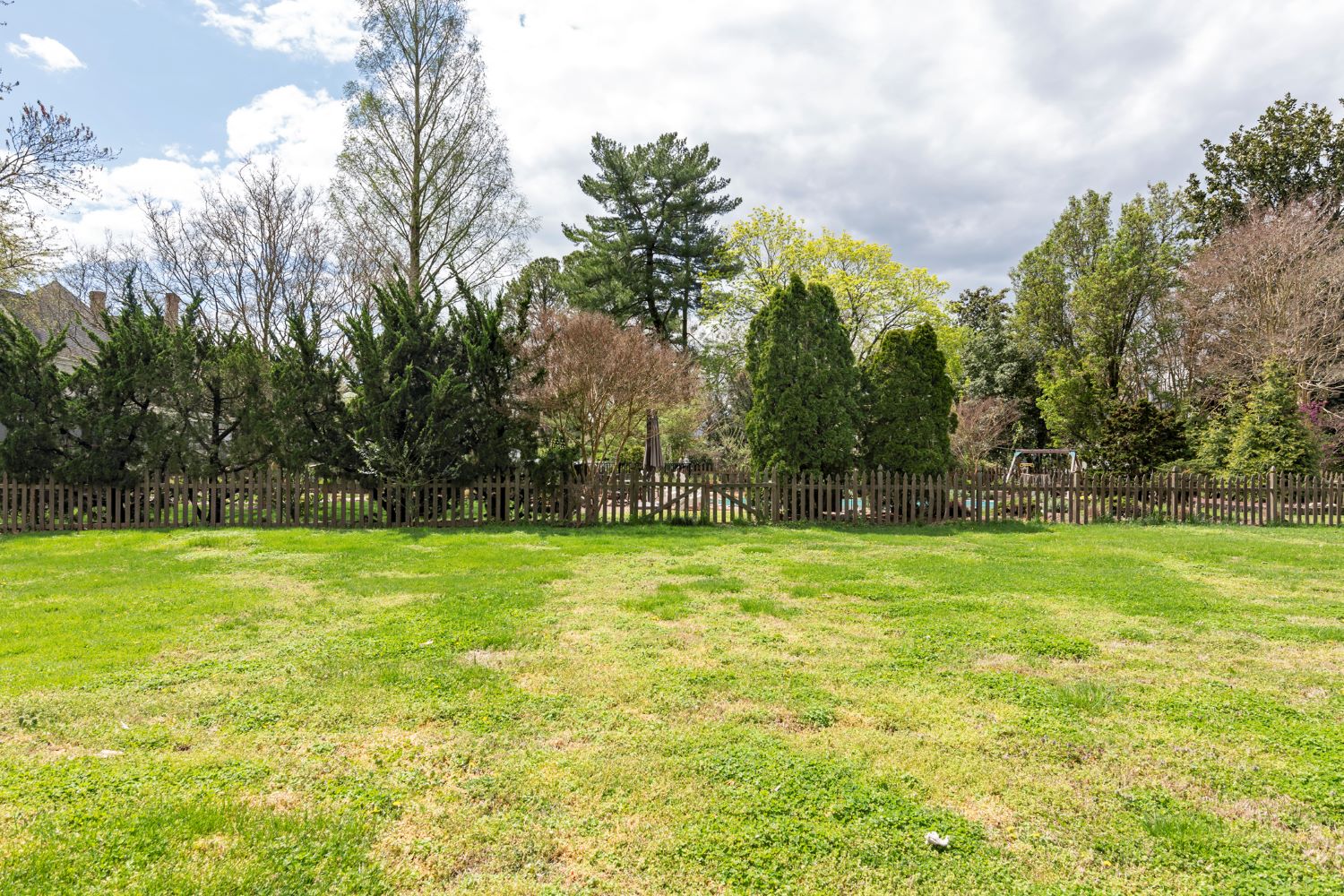
The rear yard leads to the fence.
The property’s 18,450 sf has both mature trees at the front and side of the house. The rear yard is a blank slate for myriad uses – active play, gardens, a pool or all of the above? The adjacent neighbor’s wood fence and screening creates privacy for the yard.
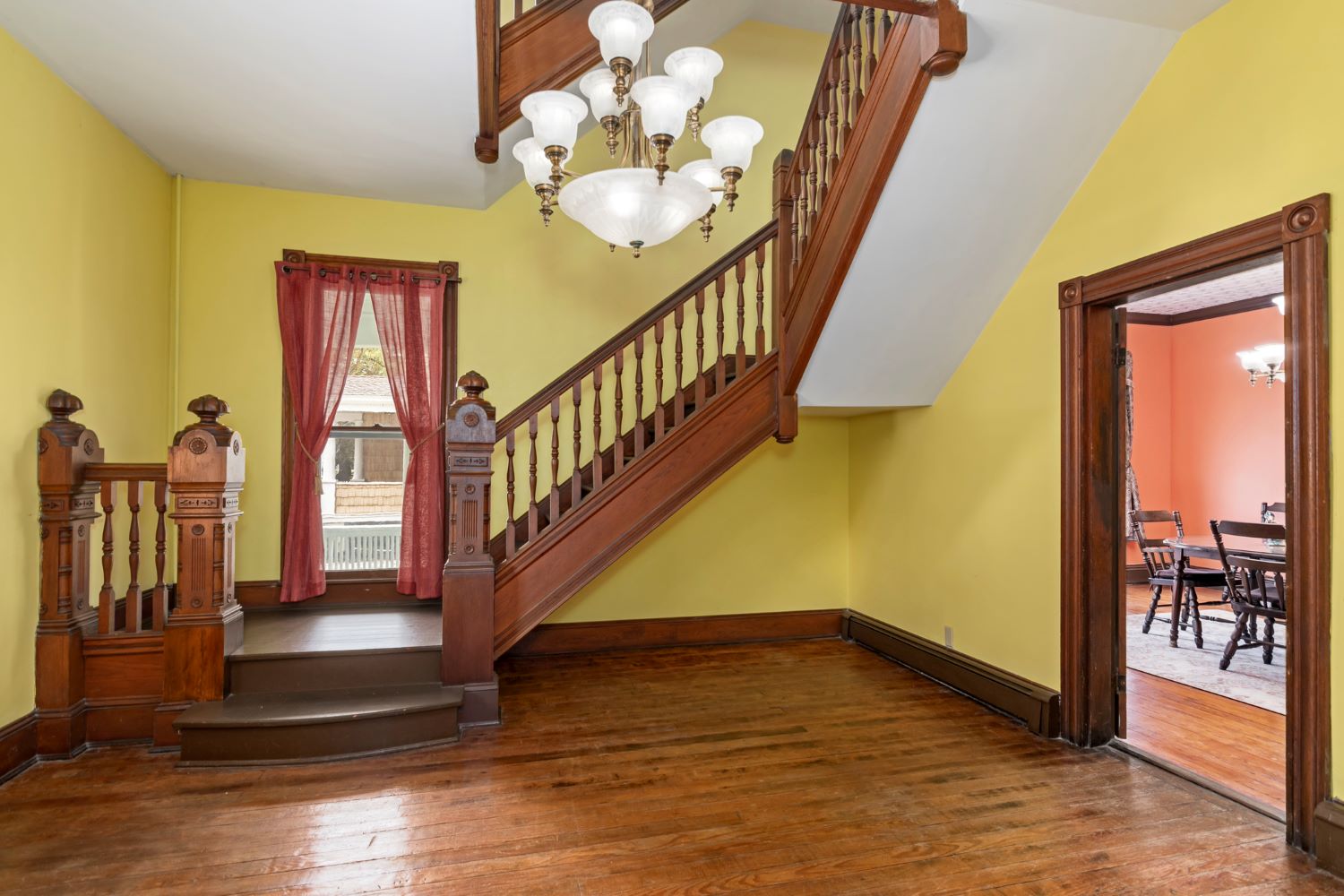
Spacious foyer featuring chestnut floors, rosette header accents, and a beautiful stairway.
The front door opens into a spacious foyer and I immediately understood why the front door was asymmetrically placed so the elegant detailing of the stairs could incorporate an enlarged landing at the lower run. I was so relieved to see that no owner had painted the exquisite woodwork so I could fully appreciate this level of artisan craftsmanship from another era. The stair’s design of sculptured newel posts, bowed first tread, turned balusters, trim on both edges of the stringer and the upper newel posts that extend just below the stringer create an exquisite focal point for the foyer. The beautiful chestnut floors, rosette header accents, baseboard and fluted trim around the doorways introduce these details found throughout the main floor. The window at the stair’s lower landing brings sunlight into the space and the period pendant fixture is an elegant finishing touch.
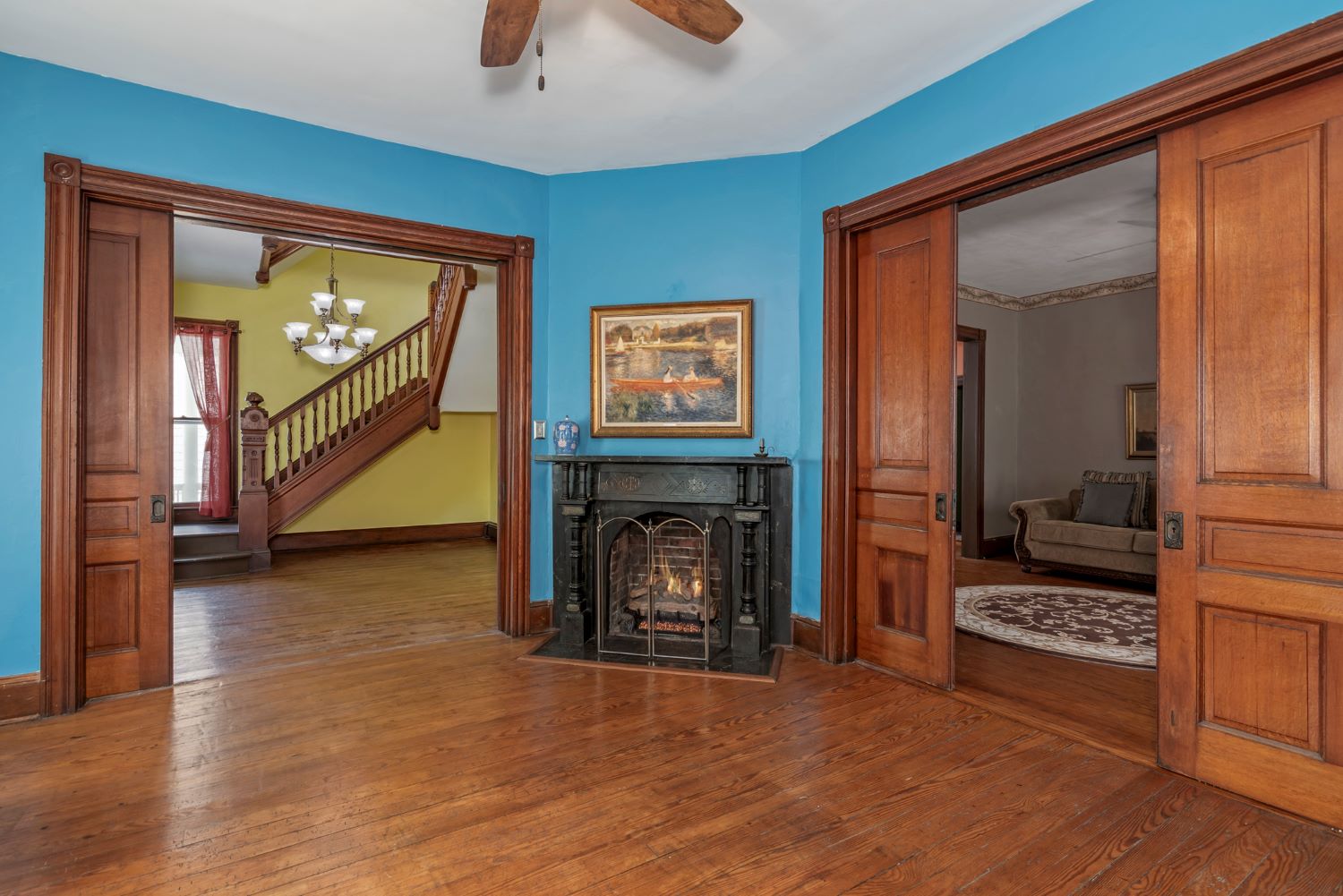
The study overlooking the porch
Two pairs of gorgeous, very wide wood-paneled pocket doors lead from the foyer into the study and the second pair leads to the living room for great flow. The study’s two front and side windows overlooking the porch filter indirect sunlight into the room and the angled wall containing the fireplace adds architectural interest to the room.

Living room featuring corner fireplace.
Behind the study is the living room which also has two pairs of double pocket doors and a corner fireplace. The living room has direct sunlight from the two side windows and a rear single window overlooking the landscape. The second set of wood pocket doors leads to the adjacent dining room.
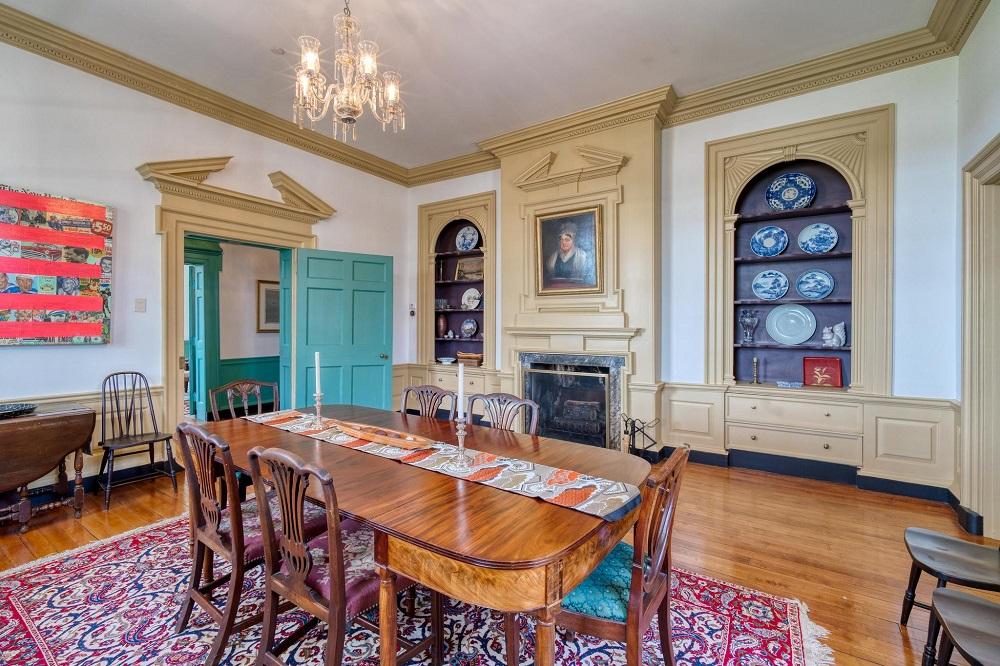
Wood trim and flooring, with the original mantel, give the dining room an elegant feel.
The dining room is also accessed by a single French door to the foyer and the exterior door with its original transom to the porch. The beautiful wood trim and flooring, the original mantel for a fireplace that has been closed off and the pressed tin ceiling pattern that reflects the light of the period chandelier create an elegant setting for family meals or for entertaining.

Former kitchen is currently used as a bedroom providing an opportunity for customization.
The trimmed wall opening at the rear of the dining room leads to the rear addition accessed by a short hall past a full bath and closet opposite the laundry/mud room. The former kitchen is currently used as a bedroom which makes this room a blank slate for one to have their own dream kitchen with single windows at each exterior wall for sunlight throughout the day.
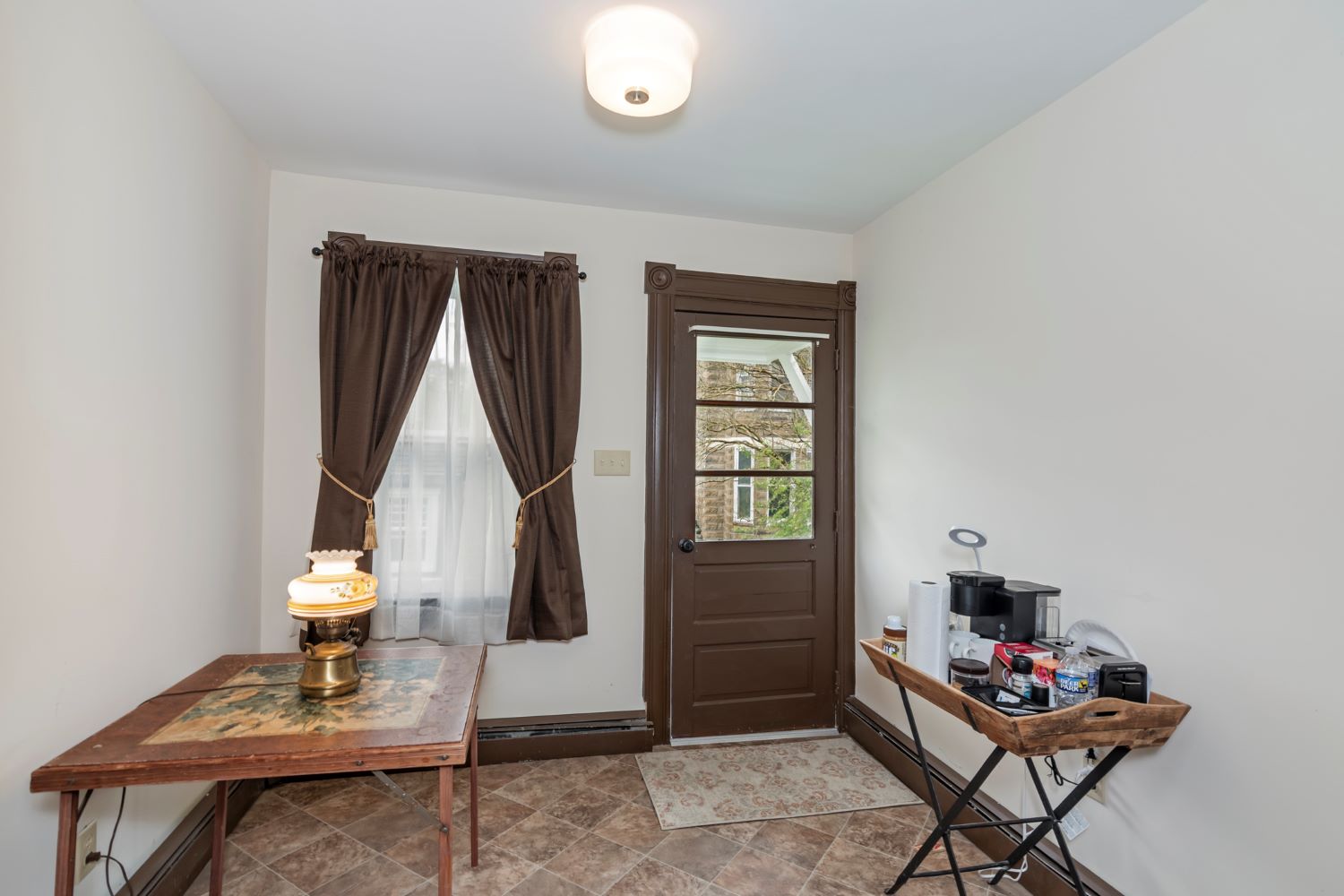
A rear entry that is easily converted to a breakfast room for a new kitchen
From the current bedroom/future kitchen, a wide-trimmed wall opening leads to the rear entry that is perfectly sized for a breakfast room for a new kitchen. I would be tempted to add two windows at the side wall to give the breakfast room a sunroom feel. The door leads to steps to the driveway for easy unloading one’s car after running errands.
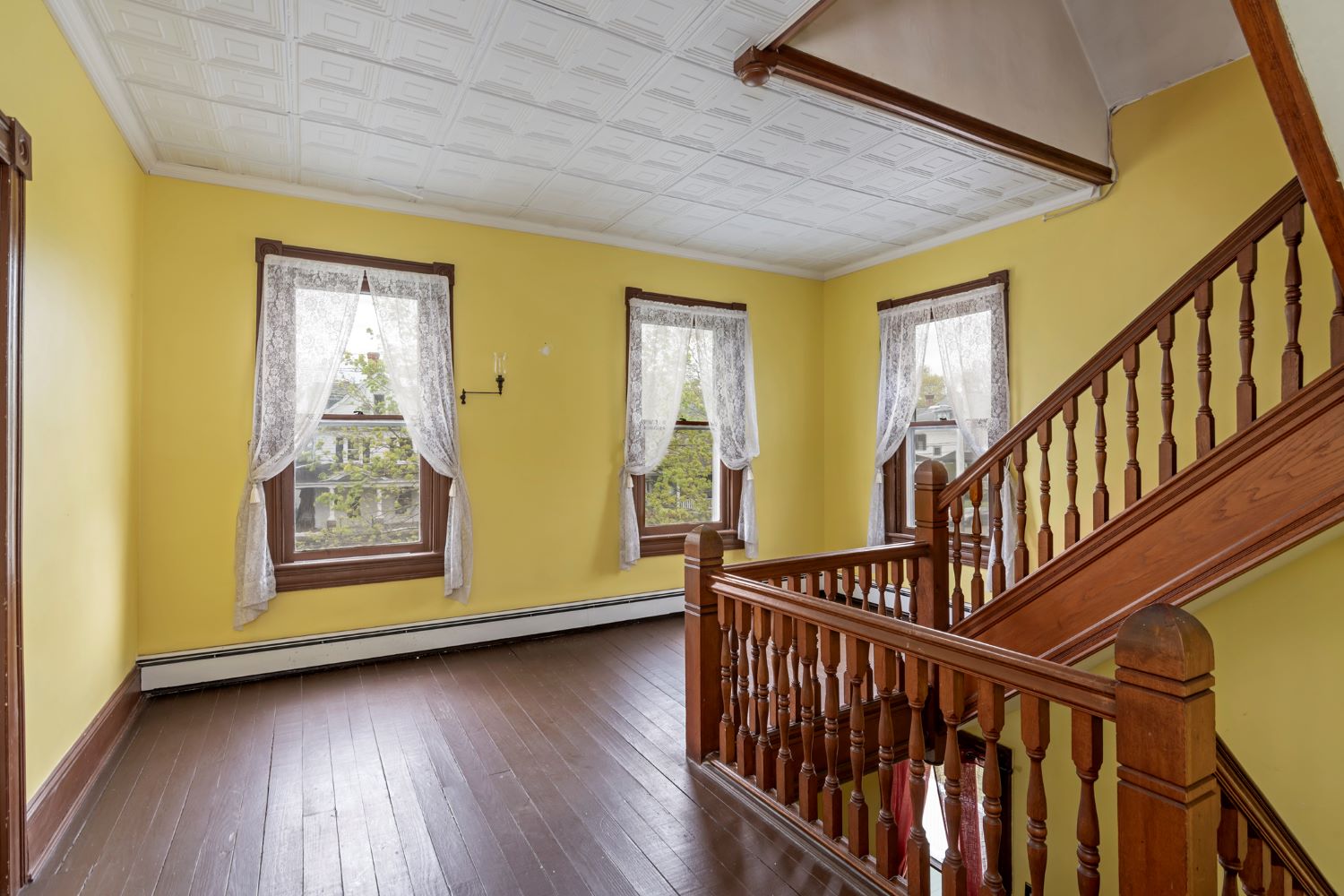
Second-floor stair landing and hall.
The staircase accesses all three floors. The three windows at the second-floor stair landing provide ample daylighting and the white pressed tin ceiling pattern reflects the sunlight.

One of three spacious bedrooms.
The second floor contains three bedrooms and the rear addition contains a hall bath and a space currently used as a kitchen. The spacious bedrooms are located at the four corners of the house so each bedroom has three or four windows for abundant sunlight. The kitchen space could be extended to the wall of this rear corner bedroom and modified to become a bath and closets for a primary ensuite. Closets from the first to the third floors could also be added for a future elevator shaft. The existing hall bath for the other two bedrooms could remain as-is, for the next Owner to upgrade to their own taste.

The third-floor layout contains a one-bedroom apartment
The third-floor layout contains a one-bedroom apartment and this light and airy open space for storage or other uses. The vinyl flooring is easy care and the high knee walls provide maneuverable headroom for a great home office or playroom, especially after an elevator could be installed.
Historic District location, close to the Choptank River and Cambridge’s attractions of the lighthouse, yacht club and downtown, great street with other large houses leading to a public waterfront green space, charming architecture in one of my fave architectural styles, a front wrap-around porch for relaxing outdoors, minimal halls for easy flow among interior rooms and a unique opportunity to own a home with the craftsmanship and interior details of an earlier era!
For more information about this property, contact Mary Losty of Compass Real Estate at 215-920-3595 (c), 410-429-7425 (o), or [email protected], “Equal Housing Opportunity”.
Photography by Eve Fishell, Chesapeake Pro Photo LLC, 443-786-8025, www.chesapeakeprophoto.com, [email protected]
The Spy Newspapers may periodically employ the assistance of artificial intelligence (AI) to enhance the clarity and accuracy of our content.
Editor’s Note: Mia Mazzeo’s essay is the winner of the Talbot County High School-Talbot Arts-Delmarva Review Youth Writing Scholarship. The award was funded by a grant from Talbot Arts and included a writing mentorship with one of the journal’s editors, publication of the student’s prose in the Delmarva Review, and a financial award.
Author’s Note: I’ve been a cinephile for a few years now, so I started writing this essay to pinpoint where exactly my love for movies began. Telling this story ended up being a very introspective experience, allowing me to reflect both on how much I’ve grown since my parent’s divorce and how film has significantly impacted my life. Movies allow us to form amazing connections and express ourselves in so many beautiful ways, and for those reasons, the silver screen will always hold a special place in my heart.
Movies and Moving
THE STAIRS of the apartment building creaked whenever I climbed them, no matter how I moved or where my feet fell. I learned this after a few times. The perpetually damp wooden boards, covered in mossy splotches and splinters, were far older than me. On the day I took that first step, however, I was not focused on the stairs’ rickety noises but on the world that was crumbling around them.
Nobody tells you what it’s like visiting the other “home” for the first time after your parents get divorced. For me, that place was my father’s new apartment. Its pale-yellow walls and scratchy tan carpet made the rooms feel surreal, like I was entering a new dimension when I walked through the door. The unfamiliarity drifting through the air that first day was asphyxiating, tightening my throat, and making my eyes well with tears. I had sworn to myself that I was not going to cry.
But standing there, in the middle of my father’s new apartment, my head began to fill with a dark, billowing storm. The news of my parents’ divorce, while expected, had never felt real to me before. Not when I noticed my father’s wedding ring was missing the day the split was announced, not even when he moved out a month later. But on that stifling June day, in a strange and sweltering apartment, a sense of anxiety overwhelmed me. The pounding in my ears grew louder—harsh thunder to my clouded, aching mind. A million questions pelted me like hard rain, but one stood out above the others: Was it all because of me?
My father stopped me as I shuffled to my new room, backpack in hand, filled with just enough clothes and items to show I was “moving in.” I was never that close with him. He worked often and was gone for days at a time. The divorce only added to the distance, as we both became more reserved, talking infrequently and exchanging only small talk. My father, sensing my unease that first day, asked if I wanted to go to the movies the next time I came over. Back then, going to the movies was a rare occurrence. But I always enjoyed it, even if we would only go once or twice a year. My father’s offer was a golden opportunity that I hoped would distract my distressed mind, so I agreed to go.
After that day, every time I walked into the movie theater with my father, I could not help but grin. We had begun a habit of seeing a movie whenever I visited the apartment, and I always looked forward to going. While it may have started as a simple distraction, it evolved into a beloved weekly tradition.
There were so many little things I loved about our trips: stopping to look at the movie posters while walking into the theater, getting a big bucket of popcorn, and relaxing in the cozy chairs of the front row, which we had both boldly deemed to be the best seats in the whole theater. What my father loved most were the trailers. When a movie looked good, he would lean over and whisper that we had to see it right when it came out. He never failed to add that last part, which always made me smile. It meant that our ritual would continue, and we’d be rushing to the theater together again.
What I loved most were our conversations after the movie. I would talk on and on about the characters and the writing, never even pausing to breathe. We would discuss every minute detail about the film and laugh all the way back to the apartment, a place I genuinely began to enjoy. Each trip brought serenity, I was never upset or anxious, and all my stress melted away with the rolling of the opening credits. Gradually, as the weeks went on, movies became one of the most important parts of my life, and with them so did my father. In our own coded language, we’d found a way to talk about things that mattered, shaped by the lives of movie characters.
Then he moved hours away to be with his new wife, and our trips became a thing of the past. With a busy schedule filled with school, sports, and clubs, it became progressively more difficult for me to go see him. Our visits dwindled to a few days a year. But he could still visit me, my mother declared. A familiar gloom returned with this thought. I knew he would never be at my door holding movie tickets or popcorn because he was too busy with the life he was living far from me. I felt the rain return—a sad drizzle. Was it all because of me?
I used to think so, but I don’t anymore. Many things in life happen out of our control, just like the weather. But even the most inclement days can feed our dreams.
Through these showers, there was always a constant, a seed nurtured by rain into something beautiful: my love for movies, a love that has grown into an immense fascination with all things film. Now, I can spend hours dissecting screenwriting—from learning the rhythm of dialogue to studying the perfect way to build tension. Whenever I find myself caught up in swirling cinema lights, it brings me the same peace I had once felt with my father. Watching movies is like a time machine, sending me back to the dim theater I shared with him, fond memories playing any time I see the big screen.
The vines of film reel have pulled me from darkness and made me more resilient than I was that first day in my father’s new apartment. Film and writing have fostered my creativity, giving me a positive outlet to share my thoughts and feelings with the world—sunshine on the face of a once closed-off girl.
♦
Mia Mazzeo, a junior at Easton High School, is the recipient of the Talbot County High School-Talbot Arts-Delmarva Review Youth Writing Scholarship (2023), with funding from a grant from Talbot Arts and supported by Talbot County Schools. The awarded student collaborates with one of the review’s editors to finalize the original prose for publication. The high school scholarship and mentoring initiative encourages outstanding writing among students in regional schools. Mazzeo is a member of the National Honors Society, Latin Honor Society, Latin club, Interact club, and Yearbook club. She is from St. Michaels, Maryland.
The Delmarva Review, a literary journal, reaches audiences regionally, nationally, and beyond, to give writers a desirable home in print (with an electronic edition) to present their most compelling new prose and poetry. This is a time when many commercial publications have closed their doors or are reducing literary content. For each annual edition, editors have culled through thousands of submissions to select the best of new poetry, fiction, and nonfiction. There is never a publishing or reading fee to the writers. The review is available from online booksellers and regional specialty bookstores. As a 501(c)(3) nonprofit, support comes from tax-deductible contributions and a grant from Talbot Arts with funds from the Maryland State Arts Council. Website: www.DelmarvaReview.org
The Spy Newspapers may periodically employ the assistance of artificial intelligence (AI) to enhance the clarity and accuracy of our content.

The Spy Newspapers may periodically employ the assistance of artificial intelligence (AI) to enhance the clarity and accuracy of our content.
Edward Hicks (1780-1849) was born in Bucks County, Pennsylvania. His father was a Loyalist who lost all his money in the American Revolution. Edward’s mother died when he was eighteen months old, and he was raised by his mother’s close friend, a Quaker. Hicks’s artistic training consisted of learning to paint decorations on coaches. In his memoirs Hicks described himself as “a weak, wayward young man…exceedingly fond of singing, dancing, vain amusements, and the company of young people, and too often profanely swearing.”
Unhappy, Hicks began to attend Quaker meetings, and he was accepted as a Quaker in 1803. He married Sarah Worstall, a Quaker. Hicks had become a minister by 1812, and an itinerant Quaker preacher in the Philadelphia area by 1813. He turned to painting as a means of earning additional support for his family. A devout Quaker, whose religion considered painting a luxury and a worldly indulgence, Hicks made paintings that fell into the category of Folk Art, its subjects coming from deep cultural roots. He began painting the Peaceable Kingdom images in 1820 to show the Quaker belief that all people were equal and should live in peace. There are sixty-two extant works titled “Peaceable Kingdom.”

‘Peaceable Kingdom of the Branch’ (1826-30)
Hicks’s paintings on the theme of the peaceable kingdom often included quotes or thoughts about peace painted on the frame. “Peaceable Kingdom of the Branch” (1826-30) (29”x36”) illustrates Hicks’s style. His depiction of Jesus in this and other paintings shows he is more adept at painting animals than humans. However, the harmony between man and nature and the undeniable charm of the animals has made Hicks an American favorite.
Jesus has one arm around the lion’s neck and holds out a branch in His hand. Although it may not look like an olive branch, the title of the work indicates the artist’s intent. He relied on the Bible for his subject matter. The Old Testament book of Genesis (8:11) tells of the dove having returned to Noah’s ark with an olive branch in its beak, the act of extending an olive branch as a symbol of peace. Olive trees need to be nurtured for at least three years until they are old enough to produce olives. In other words, they need a peaceful environment to produce their precious fruit. A lamb, ox, and goat are among the animals depicted.
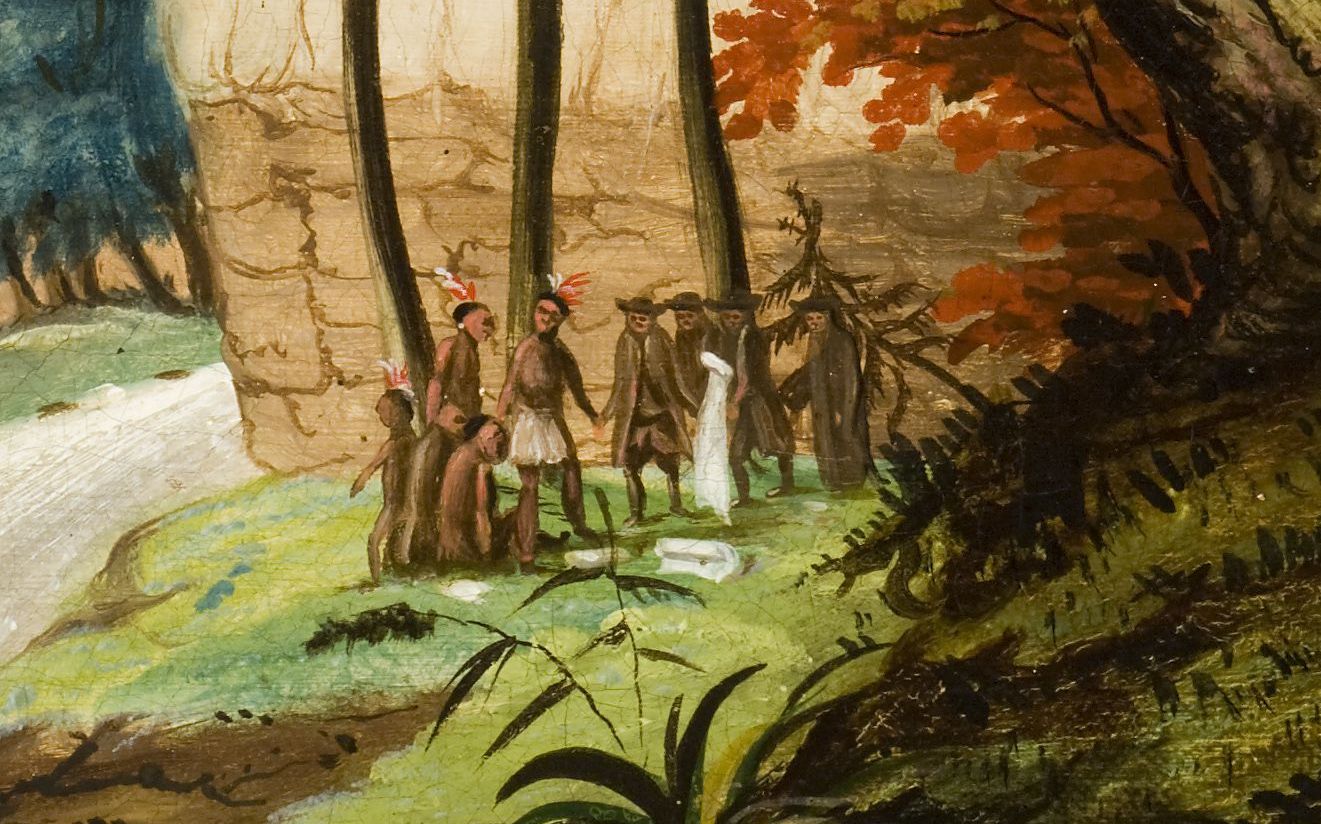
”Peaceable Kingdom of the Branch” (1826-30) detail
Hicks has included a small tableau of William Penn, a fellow Quaker, and the Lenape Indians, set beneath the magnificent Natural Bridge near Lexington, Virginia. Hicks admired Penn, who wanted to live peacefully with the Lenape’s. The Lenape believed that land was a gift from the creator and that everyone should share it equally. Penn’s treaty with the Lenape was signed in 1682 and became a frequently used subject in Hicks’s paintings, sometimes the main subject.
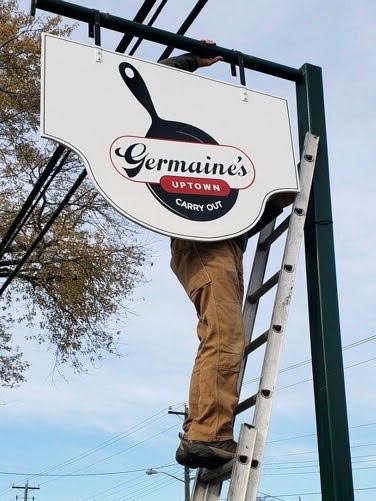
”A Peaceable Kingdom with Quakers Bearing Banners” (1829-30)
Hicks’s Peaceable Kingdom themes had several variations, but more similarities than differences. “A Peaceable Kingdom with Quakers Bearing Banners” (1829-30) (18”x24’’) is similar to “Peaceable Kingdon of the Branch” (1826-30). A small group of animals and a figure of Jesus in a pantaloon suit, popular children’s clothing at the time, are arranged at the right side of the canvas. Three clumps of olives are visible hanging from the branch. William Penn, dressed in red, stands at the center of the group of Quakers holding a banner. On it is written “Mind the Light within. It is glad tidings of great joy. Peace on earth, goodwill to all men.”

”Peaceable Kingdom” (1834)
“Peaceable Kingdom” (1834) (30”x36’’) (National Gallery of Art) depicts the child Jesus, joined by two children, and a large group of animals. Isaiah (11:6) was the inspiration for all the Peaceable Kingdom paintings: “The wolf also shall dwell with the lamb, and the leopard shall lie down with the kid; and the calf and the young lion and the fatling together; and a little child shall lead them. And the cow and the bear shall feed; their young ones shall lie down together; and the lion shall eat straw like the ox. And the suckling child shall play on the hole of the asp, and the weaned child shall put his hand on the cockatrice’s den.” Clearly visible at the left side of the canvas, Penn is trading with and negotiating his treaty with the Indians.
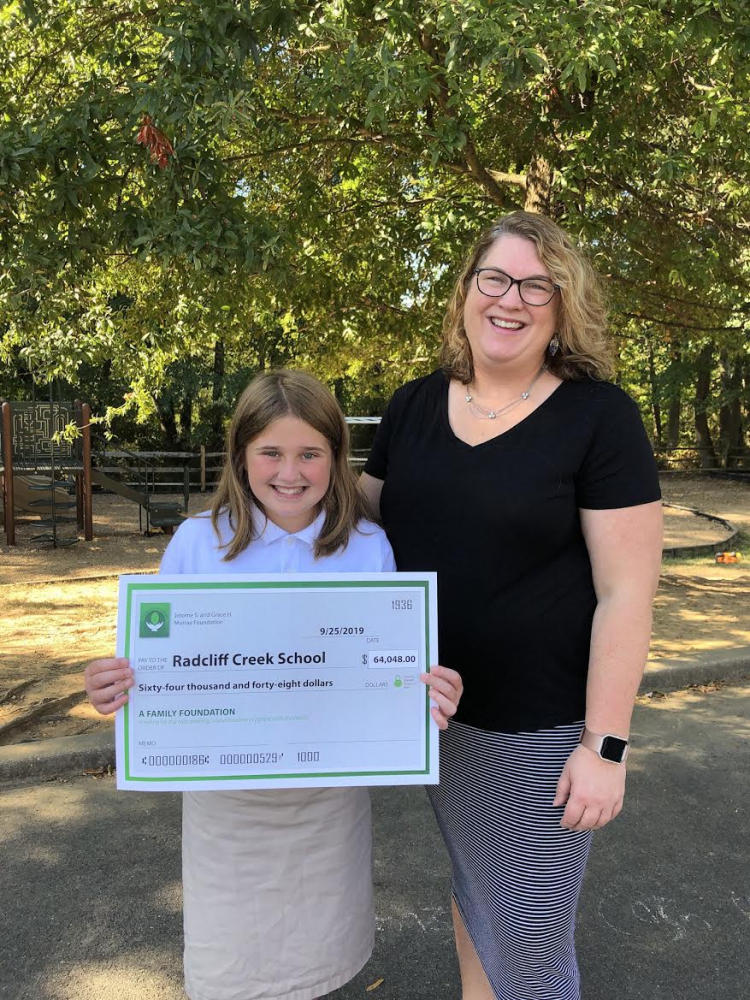
”American Noah’s Ark’ (1846)
When Hicks was not painting Peaceable Kingdoms, he occasionally tried his hand at other religious themes. “American Noah’s Ark” (1846) (27”x30’’), exemplifies the development of his painting skills with time and practice. The panoramic landscape includes water and mountains, and dark roiling clouds of the coming storm. To the lion, sheep, and goats of his earlier paintings, Hicks added horses, zebras, giraffes, camels, elephants, hippos, birds, and more. The two humans overseeing the peaceful loading of the ark are tucked behind the giraffes and camels at the far left of the scene.

“Cornell Farm” (1848)
Hicks painted “Cornell Farm” (1848) (37”x49’’) (National Gallery of Art) when he was sixty-nine years old. He signed the painting with a long inscription at the bottom: “An Indian summer view of the Farm & Stock OF JAMES C. CORNELL of Northampton Bucks County Pennsylvania. That took the Premium in the Agricultural Society, October 12, 1848, Painted by E. Hicks in the 69th year of his age.” The viewer can appreciate Hicks’s ability with perspective, creating the rolling green fields, the farmhouse and barn, and the slightly crooked rows of the planted fields in the distance. He placed a small number of figures throughout the landscape, their size decreasing size as they stand farther in the distance. And then there are the herds of horses, cows, and sheep parading across the foreground. They are an orderly group, delightful to see. Hicks made tried to make each animal three-dimensional by painting all four of its legs, but their bodies remain flat. Not to be missed are the overly large black pigs behind the animal parade.
Near the end of his life, Hicks described himself as “a poor old worthless insignificant painter.” The joy he has brought to generations of viewers would indicate that Hicks was far too modest.
Beverly Hall Smith was a professor of art history for 40 years. Since retiring with her husband Kurt to Chestertown in 2014, she has taught art history classes at WC-ALL. She is also an artist whose work is sometimes in exhibitions at Chestertown RiverArts and she paints sets for the Garfield Center for the Arts.
The Spy Newspapers may periodically employ the assistance of artificial intelligence (AI) to enhance the clarity and accuracy of our content.